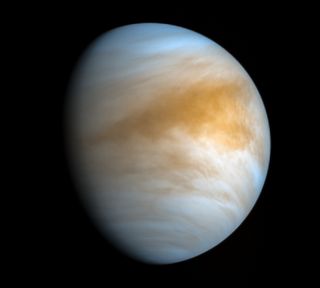Planets Thay Disappear From View for Three Days Then Rise Again
How Venus Turned Into Hell, and How the Earth Is Adjacent

Paul M. Sutter is an astrophysicist at The Ohio State University , host of Ask a Spaceman and Space Radio , and writer of " Your Place in the Universe. " Sutter contributed this article to Infinite.com'due south Expert Voices: Op-Ed & Insights .
Everyone wants to get off the planet Earth and go explore the solar system, without realizing just how good we've got it down hither. We've got a lot of air, more than liquid water than we know what to do with, a nice strong planetary magnetic field that protects the states cosmic radiation, and prissy stiff gravity that keeps our muscles strong and our bones thick.
All things considered, Earth is pretty prissy.
Related: What Would It Exist Similar to Live on Venus?
But still, nosotros expect to our planetary neighbors for places to visit and mayhap even live. And Mars has all the attention nowadays: it'southward then hot correct now, with everyone practically climbing over each other'due south rockets to go in that location in to build a nice piddling cherry-red home.
But what about Venus? It's about the same size as the Earth and the same mass. Information technology's actually a fiddling bit closer than Mars. It's definitely warmer than Mars. And so why don't nosotros try going for our sis planet instead of the ruby-red one?
Oh, that'due south right: Venus is basically hell.
Dante'due south journey
It'southward hard to not exaggerate simply how bad Venus is. Seriously, imagine in your head what the worst possible planet might be, and Venus is worse than that.
Let's kickoff with the temper. If yous call back that the smog in LA is bad, you should take a whiff of Venus. It's nearly entirely carbon dioxide and chokingly thick with an atmospheric pressure at the surface 90 times that of Earth. That's the equivalent pressure of a mile below our bounding main waves. It's so thick that you most have to swim through it just to motility around. Just four% of that temper is nitrogen, but that's more than nitrogen total than there is in the Earth's temper.
And sitting on elevation of this are clouds made of sulfuric acid. Yikes.
Sulfuric acid clouds are highly cogitating, giving Venus its characteristic brilliant shine. The clouds are then reflective, and the rest of the atmosphere then thick, that less than iii% of the sun's light that reaches Venus actually makes information technology down to the surface. That means that yous will only vaguely be aware of the difference between day and dark.
But despite that lack of sunlight, the temperature on Venus is literally hot plenty to melt pb, at over 700 degrees Fahrenheit (370 degrees Celsius) on boilerplate. In some places, in the deepest valleys, the temperature reaches over 750 degrees Fahrenheit (400 degrees Celsius), which is enough for the ground itself to glow a slow red.
And speaking of day and dark — Venus has ane of the most peculiar rotations in the solar system. For one, it rotates backward, with the sunday rise in the due west and setting in the east. Second, it'due south incredibly boring, with one year lasting only two days.
Additionally, Venus once had plate tectonics that shut off long ago, and its chaff is locked.
Yeah, Venus is hell.
Related: Photos of Venus, the Mysterious Planet Next Door
Direct to the inferno
And so how did Earth's sister end upwards and so twisted?
Because Venus is made of pretty much the same stuff as our World, and has roughly the same size and mass, scientists are pretty sure that, back in the early on days of the solar system, Venus was kind of dainty. Information technology probably supported liquid h2o oceans on the surface and white fluffy clouds dotting a blue sky. Really, quite lovely.
Simply four and a one-half billion years agone, our lord's day was different. Information technology was smaller and dimmer. As stars like our sun age, they steadily abound brighter. Then back then Venus was firmly planted in the habitable zone, the region of the solar system that can back up liquid h2o on the surface of a planet without it beingness also hot or too cold.
But as the sun anile, that habitable zone steadily moved outward. And equally Venus approached the inner edge of that zone, things started to get haywire.
As the temperatures rose on Venus, the oceans began to evaporate, dumping a lot of water vapor into the temper. This water vapor was very adept at trapping heat, which farther increased the surface temperatures, which caused the oceans to evaporate even more than, which caused even more than water vapor to get in the atmosphere, which trapped even more estrus, and then on and so on as things spiraled out of command.
Somewhen, Venus became a delinquent greenhouse with all the water dumped into the atmosphere trapping as much heat as possible, with the surface temperatures continuing to skyrocket.
The liquid h2o that had been on the surface helped keep the tectonic plates squeamish and flexible, in a sense adding lubrication to the process of plate tectonics. Only without the oceans, plate action ground to a halt, locking the surface of Venus in place. Plate tectonics play a crucial role in regulating the corporeality of carbon dioxide in the atmosphere. Substantially, carbon binds to elements in dirt and rocks, and those dirt and rocks eventually become buried far beneath the surface over the form of millions of years every bit the plates rub up against each other and sink below each other.
Simply without this process, carbon that was locked in the dirt but slowly outgassed or dumped out in massive volcanic events. So, once the oceans evaporated, the carbon trouble on Venus became even worse with zip to sequester it. Over time, the water vapor in the atmosphere got hitting by enough sunlight to break it apart, sending the hydrogen into infinite, with all that mass being replaced by carbon dioxide rising up out of the surface.
The once and time to come Earth
And equally that temper grew thicker, the conditions on the surface grew even more hellish.
The atmosphere might even have had plenty drag to literally tedious down the rotation of Venus itself, giving it its present-solar day sluggish rates.
Once this process was complete, which probably took 100 million years or so, the potential for any life on Venus was snuffed out.
And here's the worst part about the story of Globe'south twisted sister. This is our fate, too. Our lord's day isn't washed aging, and every bit it grows older, it grows brighter, with the habitable zone steadily and inexorably moving outward. At some signal within the next few hundred million years, the Earth itself will arroyo the inner border of the habitable zone. Our oceans will evaporate. Temperatures will spiral up. Plate tectonics will close off. Carbon dioxide will dump into the temper.
And past that time, our solar system will be home to not just one hell but two.
- Tin can Venus Teach Us to Take Climate Change Seriously?
- Life on Venus? Why It'south Not an Absurd Thought
- Planet Venus: Quiz Yourself on Venus Facts
Acquire more by listening to the episode "What Turned Venus Into Hell?" on the Enquire A Spaceman podcast, bachelor on iTunes and on the Web at http://www.askaspaceman.com . Thanks to @ross_trower, Russel S., and @papermonster12 for the questions that led to this piece! Ask your ain question on Twitter using #AskASpaceman or past following Paul @PaulMattSutter and facebook.com/PaulMattSutter .
Follow usa on Twitter @Spacedotcom or Facebook .
Join our Infinite Forums to keep talking space on the latest missions, dark sky and more! And if you have a news tip, correction or annotate, let u.s.a. know at: community@space.com.
Source: https://www.space.com/venus-runaway-greenhouse-effect-earth-next.html

Post a Comment for "Planets Thay Disappear From View for Three Days Then Rise Again"